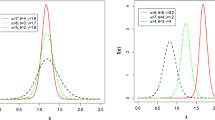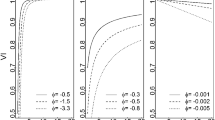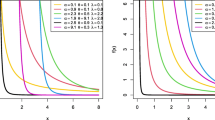Abstract
The invariant geometric structures on the statistical manifold under sufficient statistics have played an important role in both statistical inference and information theory. In this paper, we focus on one of the commonly used invariant geometric structures, the Amari–Chentsov structure, on a statistical manifold. The manifold is derived from statistical models for accelerated life tests (ALTs) with censoring based on the exponential family of distributions. The constant-stress ALTs and step-stress ALTs are considered. We show that the statistical manifold still belongs to the exponential family of distributions, but the cumulant generating function depends on a random variable related to the experimental design of the ALT, which is different from the usual situation. We also investigate the Bregman divergence and Riemannian metric. The relationships between the Riemannian metric and the expected Fisher information metric are studied. The dual coordinate system is studied by using the Legendre transformation. Then, the Amari–Chentsov structure is derived based on the two different coordinate systems. The methodologies are illustrated by using two distributions, the exponential and gamma distributions, in the exponential family of distributions. Finally, using the results of Fisher information metric, optimal designs of the two types of ALTs are presented with different optimal criteria. Finally, numerical examples are provided to demonstrate the practical applications of the results developed in this paper.

Similar content being viewed by others
References
Alkhalfan L (2012) Inference for a gamma step-stress model under censoring, Ph.D. dissertation, McMaster University
Amari S (1985) Differential-geometrical methods in statistics. Lecture notes in statistics. Springer, New York
Amari S (2016) Information geometry and its applications. Springer, Tokyo
Amari S, Barndorff-Nielsen OE, Kass RE, Lauritzen SL, Rao CR (1987) Differential geometry in statistical inference, vol 10. IMS lecture notes: monograph series. Institute of Mathematical Statistics, Hayward
Amari S, Ohara A (2011) Geometry of \(q\)-exponential family of probability distributions. Entropy 13:1170–1185
Amari S, Ohara A, Matsuzoe H (2012) Geometry of deformed exponential families: invariant, dually-flat and conformal geometries. Physica A 391:4308–4319
Ay N, Amari S (2015) A novel approach to canonical divergences within information geometry. Entropy 17:8111–8129
Ay N, Jost J, LêHV Schwachhöfer L (2015) Information geometry and sufficient statistics. Probab Theory Relat Fields 162:327–364
Balakrishnan N, Davies KF (2013) Pitman closeness results for Type-I censored data from exponential distribution. Stat Probab Lett 83:2693–2698
Balakrishnan N, Kundu D, Ng HKT, Kannan N (2007) Point and interval estimation for a simple step-stress model with Type-II censoring. J Qual Technol 39:35–47
Banerjee A, Merugu S, Dhillon I, Ghosh J (2005) Clustering with Bregman divergences. J Mach Learn Res 6:1705–1749
Barndorff-Nielsen OE (1978) Information and exponential families in statistical theory. Wiley series in probability and mathematical statistics. Wiley, New York
Cafaro C (2017) Geometric algebra and information geometry for quantum computational software. Physica A 470:154–196
Cichocki A, Amari S (2002) Adaptive blind signal and image processing: learning algorithms and applications. Wiley, New York
Geddes KO, Glasser ML, Moore RA, Scott TC (1990) Evaluation of classes of definite integrals involving elementary functions via differentiation of special functions. Appl Algebra Eng Commun Comput 1:149–165
Han D, Ng HKT (2013) Comparison between constant-stress and step-stress accelerated life tests under Time Constraint. Nav Res Logist 60:541–556
Johnson NL, Kotz S, Balakrishnan N (1994) Continuous univariate distributions, vol 1, 2nd edn. Wiley, New York
Karakida R, Okada M, Amari S (2016) Dynamical analysis of contrastive divergence learning: restricted Boltzmann machines with Gaussian visible units. Neural Netw 79:78–87
Kim S, Ng HKT, Jang H (2016) Estimation of parameters in a bivariate generalized exponential distribution based on Type-II censored samples. Commun Stat Comput Simul 45:3776–3797
Le HV (2017) The uniqueness of the Fisher metric as information metric. Ann Inst Stat Math 69:879–896
Matsuzoe H (2014) Hessian structures on deformed exponential families and their conformal structures. Differ Geom Appl 35:323–333
Meeker WQ, Escobar LA (1998) Statistical methods for reliability data. Wiley, New York
Nelson W (1990) Accelerated testing: statistical models, test plans, and data analyses. Wiley, New York
Ng HKT, Balakrishnan N, Chan PS (2007) Optimal sample size allocation for tests with multiple levels of stress with extreme value regression. Nav Res Logist 54:237–249
Ohara A (2007) Geometry of distributions associated with Tsallis statistics and properties of relative entropy minimization. Phys Lett A 370:184–193
Sha NJ, Pan R (2014) Bayesian analysis for step-stress accelerated life testing using Weibull proportional hazard model. Stat Pap 55:715–726
Sicuro G, Tempesta P, Rodriguez A, Tsallis C (2015) On the robustness of the \(q\)-Gaussian family. Ann Phys 363:316–336
Tsallis C (2009) Introduction to nonextensive statistical mechanics: approaching a complex world. Springer, New York
Wu S, Amari S (2002) Conformal transformation of kernel functions: a data-dependent way to improve support vector machine classifiers. Neural Process Lett 15:59–67
Zhang FD, Shi YM (2016) Geometry of exponential family with competing risks and censored data. Physica A 446:234–245
Zhang FD, Shi YM, Ng HKT, Wang RB (2016) Tsallis statistics in reliability analysis: theory and methods. Eur Phys J Plus 131:379
Zhang FD, Shi YM, Wang RB (2017a) Geometry of the \(q\)-exponential distribution with dependent competing risks and accelerated life testing. Physica A 468:552–565
Zhang FD, Shi YM, Zhang CF (2017b) Geometry of an accelerated model with censored data. J Comput Appl Math 317:137–145
Acknowledgements
The authors thank the anonymous referee and the editor for their useful comments and suggestions on an earlier version of this manuscript which resulted in this improved version. This work is supported by the National Natural Science Foundation of China (Nos. 11528102, 11571282, 71401134, 71571144, and 71171164), the Fundamental Research Funds for the Central Universities (Nos. JBK1801065, JBK120509, and 14TD0046) of China. H.K.T. Ng’s work was supported by a grant from the Simons Foundation (#280601).
Author information
Authors and Affiliations
Corresponding author
Rights and permissions
About this article
Cite this article
Zhang, F., Ng, H.K.T., Shi, Y. et al. Amari–Chentsov structure on the statistical manifold of models for accelerated life tests. TEST 28, 77–105 (2019). https://doi.org/10.1007/s11749-018-0587-1
Received:
Accepted:
Published:
Issue Date:
DOI: https://doi.org/10.1007/s11749-018-0587-1




